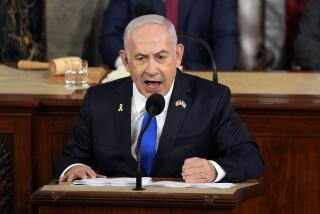Lawmakers Send Clinton $244-Billion Defense Bill
WASHINGTON — Congress gave final approval Thursday to a $244-billion defense bill that gently trims President Clinton’s spending plans while financing a new aircraft carrier and reviving the retired SR-71 Blackbird spy plane.
Reflecting a consensus that the Cold War’s end and the tight overall budget would make big spending increases difficult to justify, the House debated the measure for just 12 minutes before approving it, 327 to 86. The Senate discussed the bill for an hour before sending it by voice vote to Clinton, who is expected to sign it.
“It is a good agreement, which will provide for the safety and support of our men and women in uniform,” said Sen. Daniel K. Inouye, (D-Hawaii), who chairs the Senate Appropriations subcommittee that wrote the measure.
There were some dissenters. Liberal Sen. Dale Bumpers (D-Ark.) complained that the measure would waste billions of dollars on some weapons systems, while conservative Sen. John McCain (R-Ariz.) warned that continued low levels of spending would create “a hollow military force.”
But in the end, lawmakers sent Clinton a spending plan for fiscal 1995 that falls $822 million short of what he requested last winter, while allowing for most of his priorities. It provides $3.5 billion more than this year’s Pentagon budget, not enough to stay even with inflation.
The defense bill would provide $2.3 billion for continued work on a nuclear-powered aircraft carrier. It also supplies $100 million to keep the SR-71 Blackbird spy aircraft aloft. The Air Force, worried about the plane’s expensive operating costs, has said it is no longer needed.
The bill also makes $2.9 billion available for missile defenses, $300 million less than Clinton wanted. It also provides $2.2 billion for the purchase of six more C-17 transport planes, $300 million below the Administration’s request.
The measure also provides $728 million for the B-2 Stealth bomber program; $125 million to keep builders of the B-2 from going out of business, even though the planned number of planes have been acquired; $467 million for continued research and development, but not construction, on the V-22 Osprey, a tilt-rotor plane the George Bush Administration tried in vain to kill, and $421 million for development of a new attack submarine.
Also included are a 2.6% pay raise for military personnel; a limit of 1.5 million active troops, continuing a gradual reduction in numbers; $3.3 billion to help defense contractors convert to production of peacetime products, and $400 million to help the former Soviet states dismantle their nuclear arsenal.
The measure was the 12th of the 13 annual appropriations bills lawmakers have dispatched to the White House. Earlier Thursday, the Senate gave final approval, 89 to 11, to the $38.3-billion transportation bill.
The transportation measure finances road-building, rail and air systems throughout the country. The bill includes $40 million for renovation of Penn Station in New York.
Defense Bill Breakdown
The 1995 defense spending bill Congress sent President Clinton on Thursday:
* Total: $244 billion, $822 million less than Clinton requested and $3.5 billion more than this year’s total.
* Weapons: $2.3 billion for a nuclear aircraft carrier, $100 million to resume flights by the SR-71 Blackbird spy plane, $2.9 billion for missile defenses, $728 million for the B-2 Stealth bomber.
* Personnel: Cap of 1.5 million active troops, who would get a 2.6% pay raise.
* Former Soviet states: $400 million to help them disarm their nuclear weapons.
* Defense conversion: $3.3 billion to help defense industries retool for production of peacetime products.
Source: Associated Press
More to Read
Get the L.A. Times Politics newsletter
Deeply reported insights into legislation, politics and policy from Sacramento, Washington and beyond. In your inbox three times per week.
You may occasionally receive promotional content from the Los Angeles Times.










